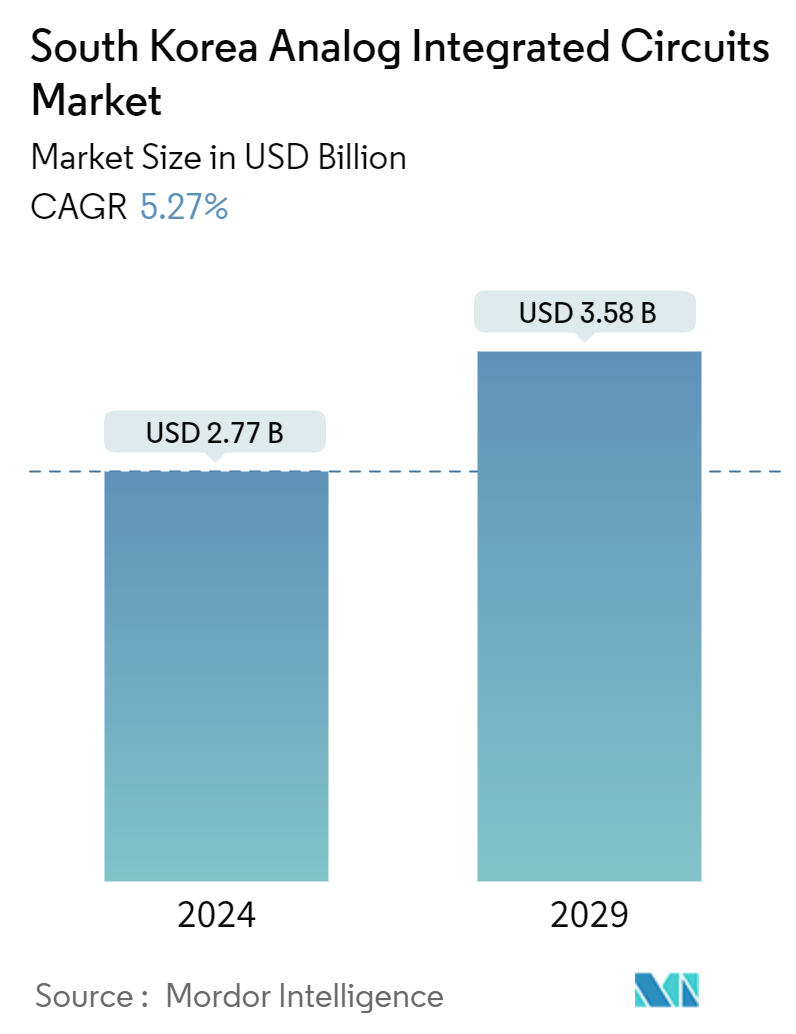Market Size of South Korea Analog Integrated Circuits Industry

| Study Period | 2018 - 2029 |
| Base Year For Estimation | 2023 |
| Market Size (2024) | USD 2.77 Billion |
| Market Size (2029) | USD 3.58 Billion |
| CAGR (2024 - 2029) | 5.27 % |
| Market Concentration | Low |
Major Players
*Disclaimer: Major Players sorted in no particular order |
South Korea Analog Integrated Circuits Market Analysis
The South Korea Analog Integrated Circuits Market size is estimated at USD 2.77 billion in 2024, and is expected to reach USD 3.58 billion by 2029, growing at a CAGR of 5.27% during the forecast period (2024-2029).
- Analog integrated circuits (ICs) are essential components in many electronic devices. They are designed to process continuous signals representing real-world phenomena such as sound, light, and temperature. Unlike digital circuits, which operate using discrete binary values (0s and 1s), analog circuits handle signals that vary smoothly over time, making them crucial for applications that require precise signal representation.
- Analog circuits can achieve high-speed processing with minimal latency. Since they process signals in their natural form without needing conversion to and from digital formats, they can respond to changes in input signals almost instantaneously. This characteristic is useful in applications like high-frequency communication systems and real-time data acquisition, where delay can significantly impact performance.
- Analog ICs can be more straightforward in design than digital circuits, especially for certain functions like amplification or filtering. This simplicity often translates to fewer components, leading to smaller circuit boards and reduced overall size of electronic devices. This compactness is a critical advantage in devices where space is at a premium, such as mobile phones and wearable technology.
- Advancements in semiconductor fabrication technologies are anticipated to have a profound impact on the analog IC market in South Korea. The transition to advanced process nodes, such as 7nm and below, will allow for better performance and lower power consumption. Techniques such as technology and silicon-on-insulator (SOI) substrates will enable the creation of analog circuits with superior characteristics, including higher speed and reduced leakage currents. These advancements are also likely to facilitate the development of mixed-signal ICs that incorporate analog and digital functionalities, further enhancing their versatility.
- Moreover, industrial automation is estimated to be a significant driver of the market studied. With the push toward Industry 4.0, manufacturers are increasingly adopting advanced automation solutions that rely on analog ICs for data acquisition and control systems.
- On the flip side, the high cost of research and development is a significant barrier to the growth of the market studied. Developing advanced ICs requires substantial investment in technology and skilled personnel, which can be prohibitive, particularly for smaller companies.
- High inflation can significantly impact the analog IC market by raising production costs. Higher prices for raw materials, components, and labor can lead to increased manufacturing expenses, which may be passed on to customers through higher product prices. This can dampen demand, particularly in price-sensitive segments.
- Inflation can strain consumer purchasing power, leading to reduced investment in advanced technologies. According to the International Monetary Fund (IMF), in 2023, the average inflation rate in South Korea amounted to about 3.59% compared to the previous year.

